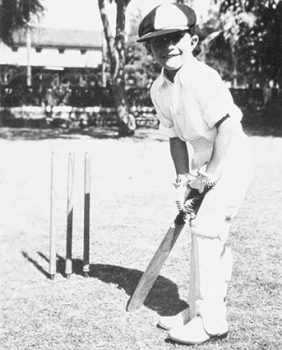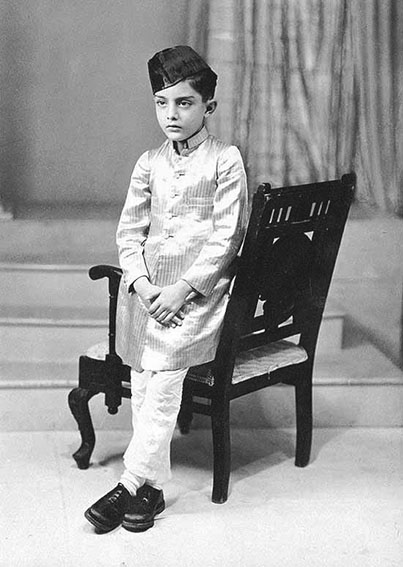In this week’s edition of In Search of West Indies Cricket, Roger Seymour, in the first of two parts, looks at the early star-crossed life of cricket’s first Superstar.
It was a chance remark heard en passant which got me thinking about the Nawab of Pataudi Jr. Someone was raving about some T20 player being a superstar, a precursory glance revealed the face of one who had just become eligible to vote. I guessed he hadn’t heard about Garry, Viv or the Nawab.
The Nawab of Pataudi Jr. could well have been a character in one of M. M. Kaye’s historical fiction novels about the British Raj in India, The Far Pavilions or Shadow of the Moon.
However, I associate him with Enid Blyton’s The Circus of Adventure. The seventh book in the Adventure series, which involves four kids Philip, Jack, Dinah, and Lucy-Ann, Kiki- Jack’s pet cockatoo, and an adult, Bill Smugs who works for some mysterious organization and is looking after the son of a friend, Gustavus ‘Gus’ Barmilevo for the holidays. The boy is actually in hiding, when suddenly one day; “Gus drew himself up to his last inch, threw back his hair once more and blurted out. ‘I am a prince!’ he said,dramatically. ‘I am the Prince Aloysius Gramondie Racemolie Torquinel of Tauri-Hessia.
……………..
”Third Test, West Indies versus India, Kensington Oval, Barbados, first day, 26th March, 1962. The two Captains descend the steps of the Pickwick pavilion and head out on to the pitch to spin the toss. Frank Worrell, the West Indian skipper flips the coin into the air, the Indian Captain calls…
…………..
To the Manor born
Mohammad Mansur Ali Khan of Pataudi was born into a life of privilege and luxury. Iftikhar Ali Khan, the Eighth Nawab of Pataudi, his father ruled over the state of Pataudi, one of 350 princely states formed by the British in India. Pataudi, with a population of 25,000 was only about the size of the English county Rutland, was located in the Punjab, in Northern India, about 30 miles south-west of Delhi.
The Pataudi heir was born in Bhopal where his maternal grandfather was the Nawab. Young Khan grew up in a 150 room white-walled palace, attended by a hundred servants, eight of whom were assigned to him. Pataudi Jr. and his three sisters were home schooled in the early years and lived a routine life of breakfast, study time, play sessions, lunch and so forth.
 Young Pataudi soon acquired a moniker, a trait that would follow him all his life. “As an infant it seems I had a tigerish propensity for crawling energetically about the floor on all fours,” he once explained in an interview, and became known as Tiger to his parents and friends. Tiger, in addition to crawling and running all over the castle, was soon introduced to cricket, hockey and football, and played with the people of the village and the palace staff.
Young Pataudi soon acquired a moniker, a trait that would follow him all his life. “As an infant it seems I had a tigerish propensity for crawling energetically about the floor on all fours,” he once explained in an interview, and became known as Tiger to his parents and friends. Tiger, in addition to crawling and running all over the castle, was soon introduced to cricket, hockey and football, and played with the people of the village and the palace staff.
As a rite of manhood for young Princes of the day, Tiger learnt to ride and shoot at an early age. “As soon as a boy-child was able to stand, he was saddled on a horse… We are basically Afghans with a bit of Turkish blood who came down a few hundred years or so ago as glorified mercenaries, rushed around on our horses and occupied space for ourselves. Over the years, we’ve become a little more sophisticated,” he later recalled. His drillmaster was very strict and had the Nawab’s permission to enforce discipline which was emphasized fairly strictly. He remembers coming face to face with his first real tiger at seven or eight, and forgetting the instructions he received before the hunt to stay in the background, he fired a shot at it, missing the animal.
In 1947, on the eve of Independence, the Eighth Nawab of Pataudi and the other heads of princely states signed the Instrument of Accession, thereby relinquishing all executive authority over their states. After independence, the Nawab got a job in the External Affairs Ministry in Delhi and his heir was sent to Welham Boys’ School, a boarding school in Dehra Dun in the foothills of the Himalayas, for three years.
Iftikhar, the only cricketer to represent both England and India, captaining the latter on three occasions, had emulated his fellow Indian royalty, K S (the Great Ranji) Ranjitsinhji, the Jam Sahib of Nawanagar and Ranji’s nephew, K S Duleepsinhji, with a century on his Ashes debut. In the Nawab’s instance, it was his also Test debut, at the SCG (Sydney Cricket Ground) in the now infamous Bodyline series in Australia in 1932-33. The Nawab disagreed with the English Captain Douglas Jardine’s tactics and eventually left the tour.
“On January 5, 1952, my 11th birthday, my father died of a heart attack while playing polo in Delhi; he was 41. The Indian government recognised me as his successor, but I was merely the titular head. It was my mother whom the family recognised as its head, which was an honour, with social and financial obligations to the family and the Pataudi community. By then, in any case, the nawabship was without executive authority, which is why I wasn’t exactly weighed down with royal responsibilities…,” was the Ninth Nawab of Pataudi’s recollection of his ascendancy.
“We Pataudis like to live life to the full and tend to die young,” the Prince would later sum up his ancestors.
…….
When the West Indies 1951-52 tour of Australia and New Zealand was over, the main body of the team sailed from Auckland to Trinidad, on the S S Ranjitoto on Friday, 29th February, 1929. Meanwhile, the professionals, Willie Ferguson, Roy Marshall, Sonny Ramadhin, Kenneth Rickards, Alf Valentine, Clyde Walcott, Everton Weekes and Frank Worrell had earlier flown to Sydney to connect with their boat bound for England.
…….
The Noob
A few weeks later the Ninth Nawab of Pataudi departed for England accompanied by his mother. The heir was destined for Lockers Park School, a preparatory boarding school in Hertfordshire, where the former England all-rounder Frank Woolley was the cricket coach. His sisters were destined for school in Switzerland. Thence, he moved on to Winchester College, a boys’ boarding school in the English public school tradition where he was the lone student of Indian descent. Winchester College, established in 1382, is the oldest of the original seven English public schools and claims the longest unbroken history of any school in England, and has been at the same location in Winchester, Hampshire for over 600 years.
At Winchester where the young Nawab was accorded no privileges, his tutors referred to him as Mansur, while his colleagues anointed him with the title of ‘The Noob.’ It was here, his love of cricket imparted to him by Iftikhar, blossomed.
In the words of his fellow alumni, David Woolley, “It [Winchester] was, and remains a curious place, regulated by ‘notions,’ these being customs and usages governing language, behaviour and dress, and enforced with a rigour which the Medes and Persians would have thought excessive. There were rules directing who might walk or sit where, a language capable of being wholly incomprehensible to outsiders…who might wear whites for cricket.”
According to The Wykehamist, the Winchester College school magazine, in July 1955, a report of the inter-house under-16 cricket competition, the Toye Cup read, “K [House], for whom Pataudi was the most prolific scorer in the competition, were not as strong as last year.”
“On arrival in the school, a boy had to play the game in grey flannels and brown boots. A moderately distinguished feat or feats with bat or ball would see him elevated to Flannel Roll, permitted white flannels and boots,” Woolley continued. The prince was soon making his first appearance for the Lords, the school’s first XI, and shortly after, he was ‘given his [white] flannels.’
The Noob’s prowess with the bat continued to grow in leaps and bounds. Woolley, ‘drawing heavily on The Wykehamist and the Wisden Cricketers Almanack’ –which records Public Schools’ cricket, and obviously still in awe at the schoolboy memories of his fellow Old Wykehamist, or Old Wok, as they would refer to each other amongst themselves, writes, ”In 1957, the storm which had long threatened finally broke. After an innings of ‘real class’ against the Bank of England, Pataudi took the MCC for 124 not out, provoking the prophetic comment that he…’ played brilliantly to score the first of what must surely be a number of centuries for lords’. This year two other features of his cricket emerged. Always an aggressive and athletic fielder, especially at cover point, he began to take wickets in the Marlborough match… His 73 not out in that [Sherbourne] match contained ‘…eleven consecutive fours; anything short of alength was hooked summarily…Pataudi seem to have aeons of time to play his strokes, and mixed a sure defensive technique with his usual range of drives, pulls and hooks.’ Two other features of this innings, were the ferocity of his when chose and the time he had in which to decide to do so.” Reads almost like P G Wodehouse’s Mike at Wrykyn.
By 1959, The Noob, as was inevitable for some time, was the Winchester captain. On his way to another century, this time against a Canadian Schoolboys touring side, he passed 1,000 runs for the season, which ended with a total of 1,068 runs, at an average of 71.20. Though he never acknowledged it publicly, removing all of Jardine’s batting records at Winchester must have been rather pleasing to The Noob.
Next week the Ninth Nawab of Pataudi enters the Test arena.










